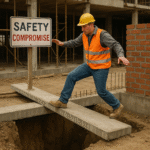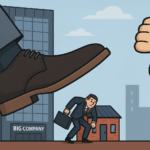|
Getting your Trinity Audio player ready...
|
Sexual harassment in Australian workplaces is not just about inappropriate touches or lewd comments – it’s a systemic issue that corrodes organizational culture from within. The legal definition under the Sex Discrimination Act 1984 frames it as any unwelcome conduct of a sexual nature that causes offence, humiliation or intimidation to a reasonable person. But what does this look like in practice?
For Hannah, a 17-year-old retail worker, it manifested as customers making sexually suggestive remarks while she tried to meet her sales targets, trapped between professional duty and personal safety. The 2025 WHS amendments have expanded this definition to include gender-based harassment – behaviours like deliberate misgendering or sexist slurs that create hostile environments, particularly for LGBTQIA+ workers.
The legal framework is finally catching up with workplace realities. Queensland’s 2025 reforms now explicitly recognize digital harassment – the unsolicited explicit DMs, the inappropriate Zoom backgrounds, the Slack messages that cross professional boundaries. This is crucial in our hybrid work era, where 22% of harassment cases occur virtually (SafeWork Australia, Feb 2025).
Yet definitions alone aren’t enough. When retail workers describe harassment as “just part of the job” (Sydney University, 2025), it reveals how normalized these behaviours have become. The law provides the framework, but changing workplace culture requires understanding these experiences in their full context – from construction site wolf-whistles to boardroom power plays.
Types of Workplace Harassment
Source: AHRC 2025 National Survey
Sector-Specific Risks: Where Harassment Thrives
The retail sector presents a perfect storm for sexual harassment: young workers, customer interactions, and power imbalances. Hannah’s experience mirrors that of 60% of young female retail employees who face harassment while trying to “build customer relationships” (Sydney University, 2025). The transactional nature of retail creates a toxic paradox: workers endure harassment to meet sales targets, while only 20% receive proper training on handling such situations (Australian Retailers Association, 2025).
This isn’t just poor management – it’s a systemic failure to protect vulnerable workers. When teenage staff learn to shrug off harassment as part of their paycheck, we’re institutionalizing harm.
Compare this to male-dominated industries like mining, where isolation and “boys’ club” cultures breed different dangers. Fly-in-fly-out (FIFO) sites report harassment rates 85% higher than office environments (WGEA, 2024), with alcohol-fueled events being prime risk factors. The 2023 case of BHP paying $12M in a class-action settlement exposed how remote worksites become lawless zones for misconduct.
Meanwhile, construction workers face the highest rates of physical harassment (70% of female workers), often dismissed as “worksite banter” (CFMEU, 2024). These sectors share a common thread: environments where power dynamics go unchecked, and harassment is dismissed as an occupational hazard rather than an organizational failure.
HARASSMENT HOTSPOTS BY INDUSTRY
The Human and Economic Toll of Harassment
Sexual harassment leaves deep psychological scars that often outlast the incidents themselves. For Hannah, the retail worker, the constant propositions and uncomfortable interactions led to chronic anxiety that persisted long after she left the job. “It sort of plays on your mind – what could I have done differently?” she reflects, echoing the self-blame many victims experience.
Clinical studies show 45% of harassment victims develop anxiety or depression, while 15% suffer PTSD symptoms. The Sydney University research found retail workers particularly vulnerable, with many young employees internalizing harassment as “just part of the job” – a dangerous normalization that compounds trauma.
The ripple effects extend beyond individuals. Workplaces with unresolved harassment cases see 18% lower team productivity (Deloitte) as victims disengage. Hannah’s experience of forcing smiles through discomfort while trying to make sales illustrates this tragic productivity paradox – workers pushing through pain to meet targets, while their mental health and work quality suffer.
Economic Consequences for Businesses
The financial costs of harassment are staggering. Deloitte estimates workplace sexual harassment costs the Australian economy $3.8 billion annually in lost productivity, recruitment, and legal fees. Individual businesses face average settlement costs of $200,000 per case (Australian Institute of Employment Rights, 2025). The retail sector’s high turnover, exacerbated by harassment, costs employers an average $23,000 per employee replaced (Australian Retailers Association, 2025).
These numbers crystallize in cases like the $12 million BHP settlement, where systemic harassment at remote mining sites led to mass resignations and reputational damage. Even when not litigated, harassment creates hidden costs: the Sydney University study found harassed retail workers were 3x more likely to quit, forcing constant retraining. As Professor Rae Cooper noted, when workers don’t feel safe, “the whole business model suffers”.
2025 Legal Reforms and Employer Responsibilities
Key Changes in Legislation
Australia’s 2025 reforms aim to become the most significant anti-harassment overhaul in decades. The National Code of Practice now mandates biannual training and anonymous reporting systems, while Queensland’s WHS amendments require specific prevention plans for high-risk industries like mining and retail (WorkSafe Queensland, 2025). Crucially, the Fair Work Commission can now impose penalties up to $1.5 million for non-compliance – a dramatic escalation from previous wrist-slap fines.
These changes respond directly to systemic failures exposed in cases like Hannah’s retail experience and the BHP class action. As Employment Minister Tony Burke stated, “We’re shifting from hoping victims complain to requiring employers to prevent” (Parliamentary address, March 2025). The reforms particularly target sectors with poor track records, requiring construction sites and FIFO mines to implement buddy systems and alcohol policies.
Practical Steps for Employers
The new “positive duty” requirements demand proactive measures. Retailers must now train staff in de-escalating customer harassment without sacrificing sales – a balance Hannah’s workplace lacked. For high-risk industries, the hierarchy of controls applies:
- Elimination: Redesign roles to avoid solo late shifts (retail) or isolated work (mining)
- Substitution: Replace alcohol at work events with team-building activities.
- Administrative controls: Implement clear reporting channels and quarterly culture audits
The Australian Retailers Association‘s new training platform exemplifies compliance, addressing the gap that workers like Hannah experience, where product knowledge training overshadowed harassment protocols. As CEO, Paul Zahra acknowledged, “The findings concerned us…we’re motivated to take action”.
2025 REFORM TIMELINE
READ ALSO: CFMEU Corruption: Crime, Cover-Ups & Govt Complicity (2025)
The Path Forward: Solutions and Systemic Change

The scars of workplace harassment linger long after incidents end. Take Priya, a migrant nurse who endured years of groping from patients before speaking up: “I stayed silent because I needed the job to sponsor my visa,” she admits (SBS News, March 2025). Her story mirrors Hannah’s retail ordeal and exposes systemic failures that the 2025 reforms aim to fix.
For too long, the burden of addressing sexual harassment has fallen on victims—a reality Hannah knows all too well. “We had training on product knowledge and making sales, but nothing on handling harassment,” she recalls. The 2025 reforms aim to change this by mandating bystander intervention training and anonymous reporting tools, but real progress requires cultural shifts.
Retail workers need scripts to firmly but professionally shut down harassment without losing sales. Mining and construction teams require on-site counsellors and mobile reporting apps for remote locations.
Critically, support must address intersectional vulnerabilities. LGBTQIA+ workers, who face double the harassment rates, need gender-inclusive policies. Migrant workers require multilingual resources—a gap highlighted when a Filipino cleaner was fired for rejecting advances but couldn’t navigate the complaint process (Sydney Morning Herald, April 2025).
Leadership Accountability and Measurement
Compliance isn’t just about checklists; it’s about measuring what matters. The Australian Retailers Association now tracks “psychological safety metrics,” while mining companies must report harassment cases quarterly to regulators. Transparency is key: Companies like Woolworths publish annual harassment data, revealing a 30% drop in incidents after implementing real-time intervention training.
But data means little without consequences. The 2025 laws allow the Fair Work Commission to disqualify directors of repeat-offender companies—a provision already used against a construction firm that ignored three harassment complaints. As Hannah puts it: “Managers need to care as much about safety as they do about sales targets.”
WHAT GOOD LOOKS LIKE
Conclusion: A Cultural Reckoning
Australia’s 2025 reforms provide the tools, but ending harassment demands daily acts of courage—from the retail worker calling out a creep, to the CEO axing a high performer who crosses lines. The stakes? As Professor Rae Cooper warns: “Without change, we’ll keep losing young talent like Hannah”. The time for half-measures is over.







